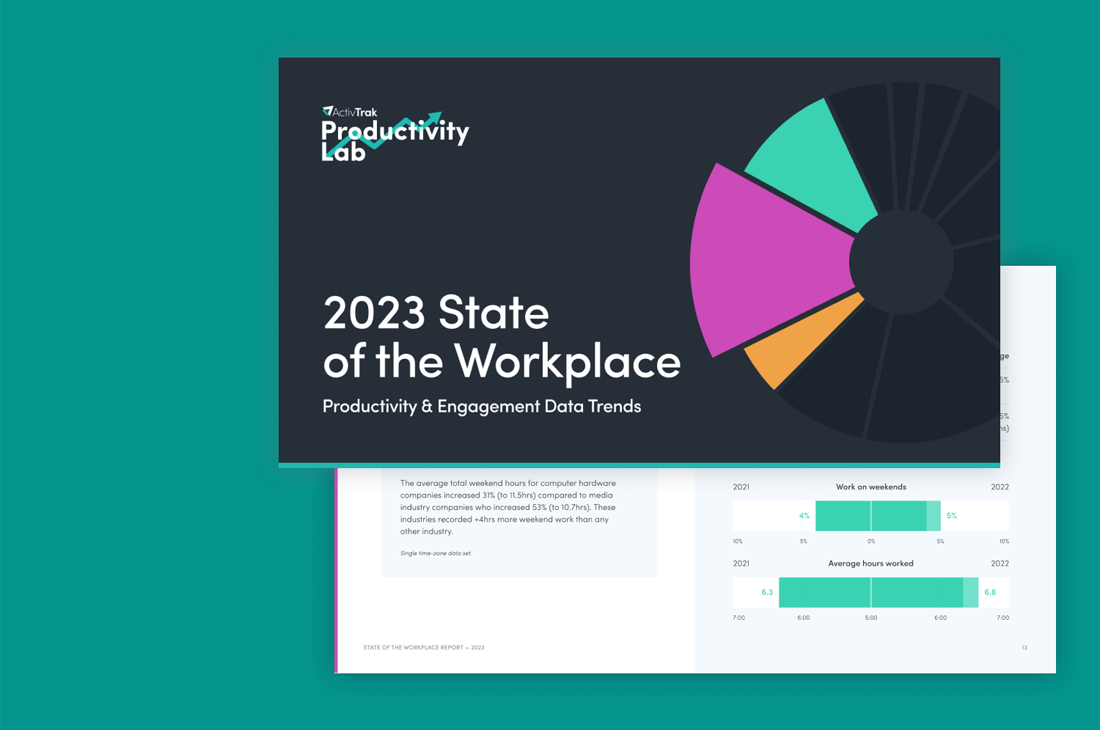Today we’re excited to launch the second edition of the Productivity Lab’s State of the Workplace Report. With data that reflects actual employee behavior over two years across 134,260 employees and 911 customers, it is one of the most direct and objective studies of when, and how, modern work happens. The study looked at year over year comparisons between 2021 and 2022, focusing on three key areas of research — productivity, well-being and technology — to reveal the current state of work and provide expert guidance for the future. Findings include:
- Productivity trended higher in the first six months of the year compared to the second
- Nearly one-third of employees are at risk of attrition due to disengagement or burnout
- Employees interacted with 20% more tools, sites and apps in 2022
In our research, we found that the stabilization of habits indicates stronger signs of a more permanent adaptation to hybrid work. We saw that weekend work persists by a similar portion of the workforce as the previous year but for longer durations of time. And finally, we uncovered the magnitude of technology proliferation in the virtual office.
In addition to uncovering workplace trends, the Productivity Lab aims to share relevant and tactical guidance so leaders at all levels of the organization can translate insights into action. With that in mind, we’ve provided five helpful tips across our areas of study.
Productivity
- As the average work day spans 10+ hours, establish core working hours and Flexibility Agreements to support synchronous collaboration and preserve time for employee choice. Flexibility means not all employees will choose to work at the same times throughout the day, which is okay provided you have clearly articulated organizational guardrails to balance flexibility with accountability. Flexibility agreements provide a straightforward, low-cost, high-value solution that codify when the entire organization should be accessible and online, helping to preserve productive collaboration time.
- Embed a goal-setting alignment exercise at the half-way point in the year to avoid the second half dip in productivity. At the start of the year, businesses invest significant time getting teams aligned to goals and strategies. To re-energize the organization and demonstrate agility, a goal-setting alignment exercise at the team and individual level can help with sustaining productivity through the rest of the year.
Well-being
- As employee workloads inevitably ebb and flow with business activity, proactively manage these peaks and valleys with effective and thoughtful 1:1 discussions. Do this by reviewing how the workload feels, discussing when it’s expected to pick up, and encouraging employees to routinely prioritize projects to avoid drastic peaks that lead to burnout.
- Create frontline manager-led discussions around engagement efforts where burnout, disengagement, misalignment and other concerns can surface. Addressing these issues 1:1 with a direct manager can often be uncomfortable and intimidating. Similarly, when leaders hold these discussions, employees may be hesitant to give real feedback. Recurring optional focus groups led by mid-level managers give employees and their peers a forum to share open and honest feedback about what impacts their engagement most. It can be helpful for HR business partners to attend to respond to such concerns with available resources and upcoming solutions.
Technology
- Establish a routine cadence (monthly) to review new technologies added to the tech stack and evaluate how they contribute to or detract from what already exists. This helps organizations better understand 1) where duplicative tools may emerge over time, 2) what unnecessary license costs exist, and 3) how workflows can be interrupted as a result of misaligned tools, and more. The emphasis here is to evaluate early and often.
When it comes to ensuring employee well-being while increasing productivity, organizations will need to continue to listen and respond to their workforce. The stabilization seen in our data doesn’t necessarily mean these habits are here to stay — but rather, that we’ve seen the fruits of our past efforts and it’s time to adopt more progressive strategies to uplift our teams. Our team at the Productivity Lab is eager to continue our research and provide guidance in the months to follow.
About the ActivTrak Productivity Lab
The Productivity Lab’s purpose is to help organizations leverage people, process and technology data to improve sustainable workplace productivity. We utilize insights from across our customer base to identify trends, strategies and obstacles in today’s ever-changing work environment. Our findings are expanded through market research and strategic alliances. As a global center for productivity research and expertise, we are committed to helping organizations evolve, embrace and embody the future of work.





